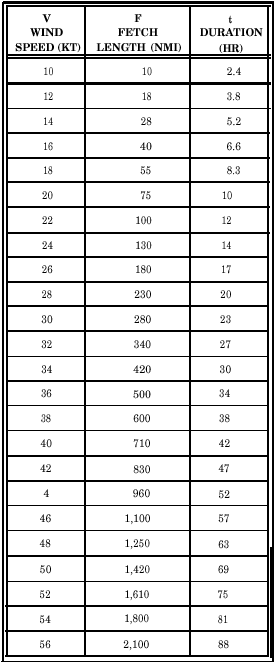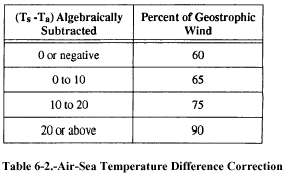DETERMINING THE WIND FIELD As we have discussed, wind is the cause of waves. It therefore stands to reason that in order to accurately predict sea conditions, it is necessary to determine wind properties as accurately as possible. Miscalculation of fetch, wind speed, or duration will lead to inaccuracies in predicted wave conditions. As we have discussed, wind is the cause of waves. It therefore stands to reason that in order to accurately predict sea conditions, it is necessary to determine wind properties as accurately as possible. Miscalculation of fetch, wind speed, or duration will lead to inaccuracies in predicted wave conditions.
In this section, we present methods of determining the wind properties as accurately as possible with the available data.Table 6-1.-Minimum Wind Speed (V), Minimum Fetch Length (F), and Minimum Duration Time (t) Needed to Generate a Fully Developed Sea In all cases, the first step toward a wave forecast is locating a fetch. A fetch is an area of the sea surface over which a wind with a constant direction and speed is blowing. Figure 6-4 shows some typical fetch areas. The ideal fetch over an open ocean is rectangular shaped, with winds that are constant in both speed and direction. As shown in figure 6-4, most fetch areas are bounded by coastlines, frontal zones or a change in isobars. In cases where the curvature of the isobars is large, it is a good practice to use more than one fetch area, as shown in figure 6-4(B). Although some semipermanent pressure systems have stationary fetch areas, and some storms may move in such a manner that the fetch is practically stationary, there are also many moving fetch areas. Figure 6-5 shows three cases where a fetch AB has moved to the position CD on the next map 6 hours later. The problem is determining what part of the moving fetch area to consider as the average fetch for the 6-hour period. In figure 6-5, Case 1, the fetch moves perpendicular to the wind field. The best approximation is fetch CB. Therefore, in a  forecast involving this type of fetch, use only the part of the fetch that appears on two consecutive maps. The remaining fetch does contain waves, but they are lower than those in the overlap area. forecast involving this type of fetch, use only the part of the fetch that appears on two consecutive maps. The remaining fetch does contain waves, but they are lower than those in the overlap area.In figure 6-5, Case 2, the fetch moves to leeward (in the same direction as the wind), Since waves are moving forward through the fetch area, the area to be used in this case is fetch CD.Case 3, figure 6-5, depicts the fetch moving windward (against the wind). Since the waves move toward A, the region AC will have higher waves than the area BD. Experience has shown that in this case AB is the most accurate choice for a fetch,Determining Accurate Wind SpeedThe most obvious and accurate way to determine wind speed over a fetch is to average the reported values from ships. This method has the advantage of not requiring a connection for gradients or stability. But often there are only a few ship reports available, and ship reports are subject to error in observation, encoding, or transmission. This method has the advantage of not requiring a connection for gradients or stability. But often there are only a few ship reports available, and ship reports are subject to error in observation, encoding, or transmission.
A second way to determine wind speed is to measure the geostrophic wind from the isobaric spacing and then correct it for curvature and stability. At first it would seem this would be less desirable due to the extra time necessary for corrections.However, barometric pressure is probably the most reliable of the parameters reported by ships, and a reasonably accurate isobaric analysis can be made from a minimum number of reports. For these reasons the corrected geostrophic wind is considered to be the best measure of wind speed over the fetch, except of course in cases where there is a dense network of ship reports where wind direction and speed are in good agreement.The reason for correction to geostrophic wind is that the isobars must be straight for a correct measure of the wind. When the isobars curve, other forces enter into the computations. The wind increases or decreases depending on whether the system is cyclonic or anticyclonic in nature. The stability correction is a measure of turbulence in the layer above the water. Cold air over warmer water is unstable and highly turbulent, making the surface wind more nearly equal to the geostrophic wind. Conversely, warm air over colder water produces a stable air mass and results in the surface wind being much smaller than the geostrophic wind.Three rules for an approximation of the curvature correction are as follows:For moderately curved to straight isobars-no connection is applied.For great anticyclonic curvature-add 10 percent to the geostrophic wind speed.For great cyclonic curvature-subtract 10 percent ffom the geostrophic wind speed.
In the majority of cases the curvature correction can be neglected since isobars over a fetch area are relatively straight. The gradient wind can always be computed if more refined computations are desired. In order to correct for air mass stability, the sea air temperature difference must be computed. This can be done from ship reports in or near the fetch area aided by climatic charts of average monthly sea surface temperatures when data is too scarce. The correction to be applied is given in table 6-2. The symbol Ts stands for the temperature of the sea surface, and Ta for the air temperature. In order to correct for air mass stability, the sea air temperature difference must be computed. This can be done from ship reports in or near the fetch area aided by climatic charts of average monthly sea surface temperatures when data is too scarce. The correction to be applied is given in table 6-2. The symbol Ts stands for the temperature of the sea surface, and Ta for the air temperature.
Determination of Wind DurationOnce a fetch has been determined and the wind speed has been found, the next step is to determine the duration of that wind over the fetch. It is highly unlikely that the wind will begin and end at one of the 6-hour map times. Therefore an accurate value must be interpolated. Inmost cases a simple interpolation of the successive maps will be sufficient to locate the bounds of the wind field in space and time.Determining how long the wind has blown is relatively simple when the wind speed has bee n constant for the entire duration. If this does not occur, a representative duration must be selected.SLOWLY VARYING WIND.— Suppose the wind has been blowing for 24 hours, with velocities of 10 knots for 6 hours, 15 knots for 12 hours, and 20 knots for 6 hours. The duration is 24 hours but the speed value is in question. The most consistent solution is to use three durations with the corresponding wind speeds and work up three successive states.MORE RAPID VARIATIONS.— Suppose the wind blows for 12 hours and during that time it increases in velocity from 10 to 20 knots. Studies and experience have shown that in cases of variable winds a single value may be assigned for wind speed if the change has been relatively small. The following rules can be applied under these conditions:Average the speeds when the change is gradual or increasing or decreasing. Apply the average to the entire duration.Use the last wind speed when the speed changes in the first few hours, then remains constant. Apply that speed to the entire duration.
|